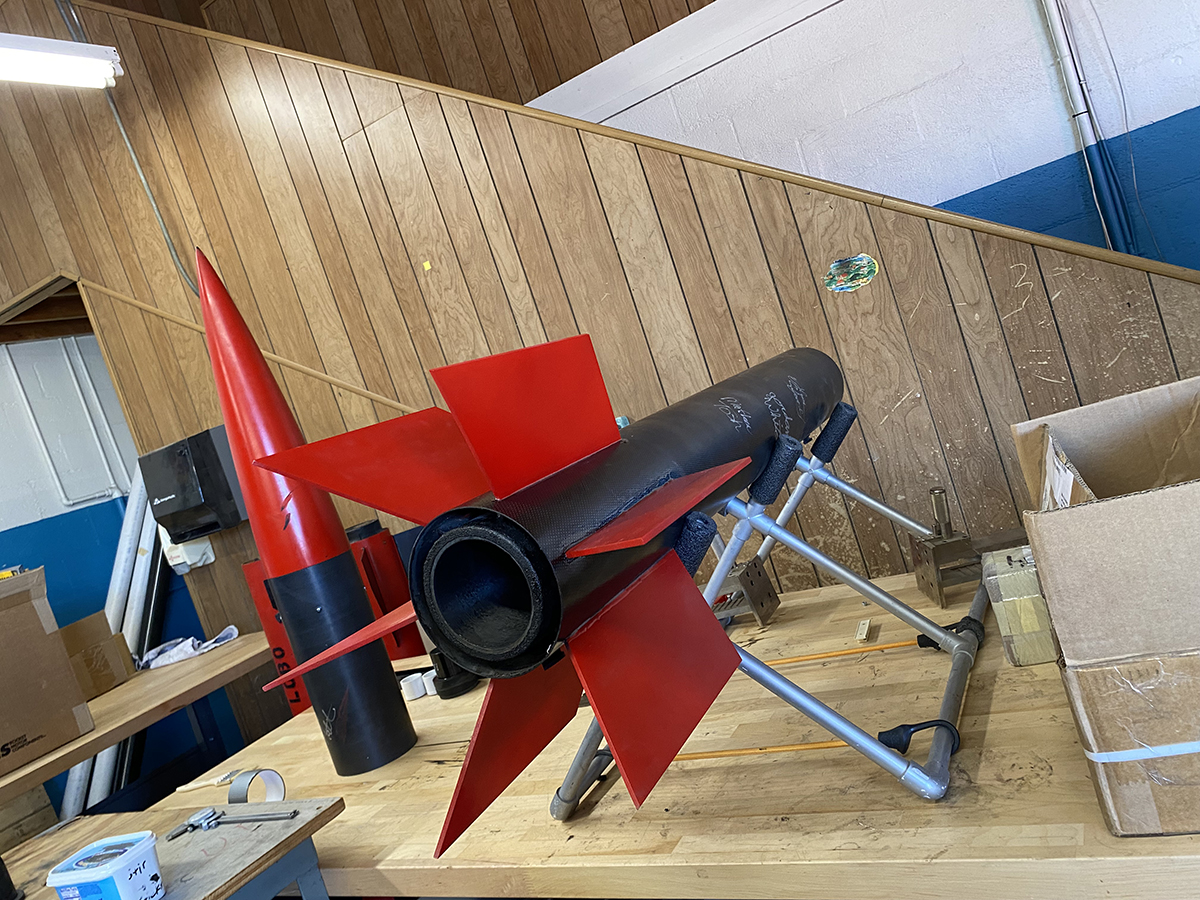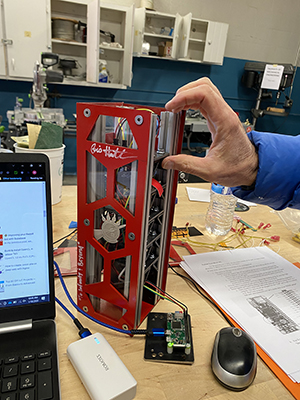Recent News
Perfetti receives ANS Landis Engineering Achievement Award
June 26, 2025
Engineering a new treatment for ovarian cancer
June 24, 2025
UNM engineers win 2nd place at RMWEA design competition
June 20, 2025
UNM places first at solar boating championship
June 10, 2025
News Archives
UNM’s Lobo Launch team preparing to compete in Spaceport America Cup in June
January 25, 2022 - by Kim Delker
After a two-year hiatus due to the COVID-19 pandemic, The University of New Mexico’s Lobo Launch rocket team is set to compete in the Spaceport America Cup near Las Cruces this summer.

The 10-foot rocket that will compete at Spaceport America Cup.
The competition, scheduled for June 21-25, will feature more than 150 university teams from around the nation and the world, including groups from as far away as Turkey, Greece, Poland and India. Participation is lower than normal this year due to COVID.
Fernando “Doc” Aguilar is the UNM rocket engineering professor and directs the rocket program at UNM. He came to UNM after a long career as a launch controller and space operations officer in Air Force Space Command. He said the 11 mechanical engineering students on the team this year are eager to compete in person and are primed for another success at Spaceport America Cup.
“We are in the final stages of fabrication and will begin test flights at the beginning of February,” he said.
The team partners with the Albuquerque Rocket Society, which enables them to launch under the society’s FAA flying waiver and to utilize the launch space on the northwest side of the city.
The test launches enable the team to make modifications to the rocket and test them out in plenty of time for the June competition.
In 2019, the team made its debut in the competition, placing No. 5 overall and No. 3 in its rocket class, out of 225 teams from 14 countries. Aguilar said the team made some changes after the results of the 2019 competition, in which the rocket overshot the 10,000-foot target altitude by 600 feet.
“To reduce the apogee, we could either add weight or increase drag,” he said. “We cannot add ballast because the rocket would not conform to Spaceport America guidelines for minimum speed leaving the launch rail. So, the students tapped into their knowledge gained during fall semester and determined that an additional fin will bring the apogee down to 10,000 feet.”

The 2019 rocket had an unusual five fins (the norm is four) for the same reason, and this year’s rocket will fly with six fins.
This year, the Lobo Launch team is building two rockets: one that will compete and the other for an exhibition launch. The exhibition rocket will stand 50 feet tall and has been dubbed BFLR, for Big Fat Lobo Rocket. The competition rocket is a high-performance design that is only 10 feet long, Aguilar said.
The team is also outfitted with some new aerospace ground equipment, thanks to generous donations from mechanical engineering alumnus Roger Koerner. Koerner’s donation allowed the team to purchase a large, deployable climate-controlled enclosure that the team can set up on site at the Spaceport America Cup. This will shield the rocket and delicate payload from the triple-digit heat in June. The donation also allowed the team to purchase a “mobile command post” trailer, outfitted with electrical power, drawers, cabinets and tie-downs for equipment, as well as computer hookups. This high-tech trailer will serve as a mobile rocket assembly facility and allow the team to safely transport the rocket and spare parts to competition.
Aguilar said that in addition to testing early and getting the rocket in good shape for competition, he also wants the team to launch first on the first day (as they did in 2019). This will earn the team 200 points that are awarded only to the first team to launch. In addition, he said the team has developed an innovative experiment for the payload. This will put the team an additional 200 points ahead of the competition.
“Our students are most pragmatic and innovative in developing a winning rocket,” Aguilar said. “They determined that the modeling and sim software is not accurate for supersonic speeds. Their quandary was how to develop a rocket that could attain 10,000 feet and still remain sub-sonic. Their solution was a low-thrust motor with a very long burn (14 seconds). So our test flight results are very near what the models indicate. All other teams use high-thrust motors with very short burns (4-6 seconds), forcing them to go supersonic to achieve the competition altitude. However, they do not get accurate results from their modeling.”
He said that the UNM team has a unique advantage that will always benefit them, and not just because of the proximity to competition.
“We have another advantage over most other university teams because we can test launch at nearly the same altitude as the competition site,” he said. “That is not the case for most schools in the U.S. or around the world.”
The program is funded mostly by donations, which can be made online.
